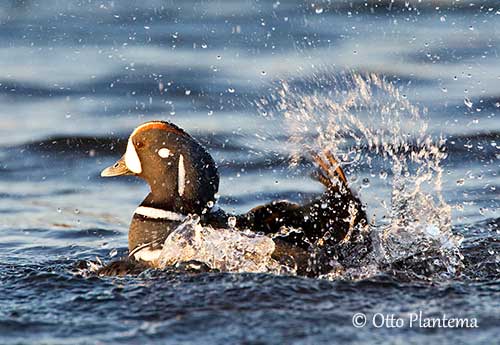
Fr: Arlequin plongeur
Ang: Harlequin Duck
All: Kragenente
Esp: Pato Arlequín
Ita: Moretta arlecchino
Nd: Harlekijneend
Sd: Strömand
Photographers:
John Anderson
John Anderson Photo Galleries
Tom Grey
Tom Grey's Bird Pictures
Paul Guillet
Photos d’Oiseaux
Tom Merigan
Tom Merigan’s Photo Galleries
Otto Plantema
Trips around the world
Text by Nicole Bouglouan
Sources:
HANDBOOK OF THE BIRDS OF THE WORLD vol 1 by Josep del Hoyo-Andrew Elliot-Jordi Sargatal - Lynx Edicions - ISBN: 8487334105
THE HANDBOOK OF BIRD IDENTIFICATION FOR EUROPE AND THE WESTERN PALEARCTIC by Mark Beaman, Steve Madge - C. Helm - ISBN: 0713639601
L’ENCYCLOPEDIE MONDIALE DES OISEAUX - Dr Christopher M. Perrins - BORDAS - ISBN: 2040185607
GUIDE DES CANARDS, DES OIES ET DES CYGNES – de Steve Madge - Delachaux et Niestlé - ISBN: 2603013769
Animal Diversity Web (University of Michigan Museum of Zoology)
All About Birds (Cornell Lab of Ornithology)
Bird Web (Seattle Audubon Society)
What Bird-The ultimate Bird Guide (Mitchell Waite)
Harlequin Duck
Histrionicus histrionicus
Anseriformes Order – Anatidae Family
INTRODUCTION:
The Harlequin Duck is a beautiful and powerful sea duck. It favours the mountain streams in summer, diving and swimming against the current of rushing rivers. During winter, it occurs at sea in rocky coastal waters and wild coastlines where the waves break on rocks.
The name of this small sea duck “harlequin” comes from its colourful plumage. It is the only remaining species of the genus Histrionicus and it is monotypic. It breeds in NW and NE North America, Greenland and Iceland, and disperses along the sea coasts in winter, within the breeding range.
The Harlequin Duck is not threatened and the overall population trend is currently increasing.

DESCRIPTION OF THE BIRD:
Biometrics:
Length: 38-50 cm
Wingspan: 61-70 cm
Weight: M: 580-750 g – F: 485-680 g
The adult male has blue-grey plumage, darker when seen at distance. It has distinctive white markings on head and body.
On the upperparts, upper back and mantle are darker bluish. The white scapulars show narrow dark grey fringes. Tail and rump are black. The upperwing is blue-grey with blackish flight-feathers. We can see a short white wingbar and a purplish-blue speculum.
On the underparts, the plumage is blue-grey with conspicuous chestnut flanks, and long, white, vertical bar bordered black on each side of the breast. There is a small white spot on rump sides. The underwing is mostly brown.
The head is blue-grey with conspicuous white crescent at base of bill extending up to lores and forecrown, a small white ear patch and a vertical white stripe on neck sides. A broad black median stripe extends from the upper base of the bill to the rear crown, bordered on both sides with white and chestnut. We can see a white neck-collar broken at front and back.
The bill is grey-blue with paler tip. The eyes are reddish-brown. Legs and feet are bluish-grey.
The adult female has dark brown head and neck with white patch behind, below and in front of the eye to forehead. The plumage is blackish brown, mostly greyish below and whitish on the undertail-coverts. Except the eyes, the bare parts are duller than in male.
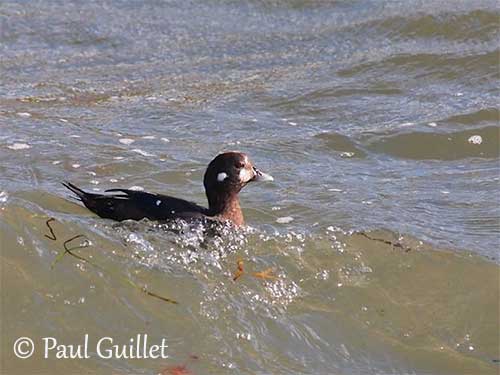
The male in eclipse plumage resembles female, but darker brown to dark grey with white, black-fringed innermost tertials.
The juvenile also resembles female but it has paler upperparts and more spotted underparts. It attains the full adult plumage in the second year.
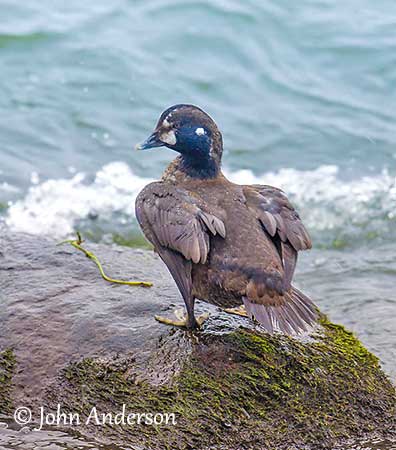
RANGE:
The Harlequin Duck breeds in Alaska and Yukon, S to SE Idaho, California and Massachusetts. It also breeds in E Canada, S to Gulf of St Lawrence, Greenland and Iceland, and probably Baffin Island.
It winters along the coasts off Korea and Japan, and in USA in Maryland and N California.
HABITAT:
The Harlequin Duck breeds along the fast flowing rivers in hilly and mountainous country, and around rapids and waterfalls, but usually in rocky area with trees. It may reach high elevations of up to 3350 metres.
It winters along rocky coastlines, in shallow waters usually within 300 metres from the shore. It often dives among the heavy surf of the breaking waves. It is rarely seen in sheltered bays, but sometimes around harbours.
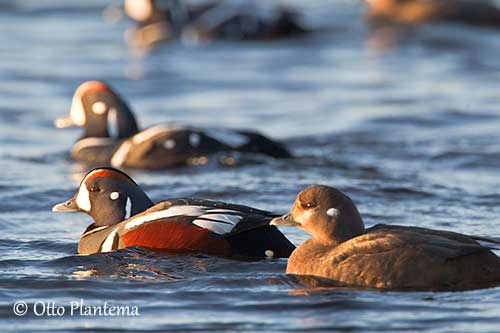
CALLS AND SONGS: SOUNDS BY XENO-CANTO
The Harlequin Duck is usually silent outside the breeding season. The male becomes more vocal during the displays, uttering a high-pitched squeaking whistle, increasing as displays intensify. The female gives several short, harsh calls.
BEHAVIOUR IN THE WILD:
The Harlequin Duck feeds primarily on molluscs, crustaceans and insects (adults, larvae and pupae) in spring and summer.
At sea, its diet consists mainly of mussels, shellfish, aquatic insects, crustaceans and occasionally small fish and marine worms.
On rivers during the breeding season, it feeds mostly on aquatic insects and it may take small amounts of plant material.
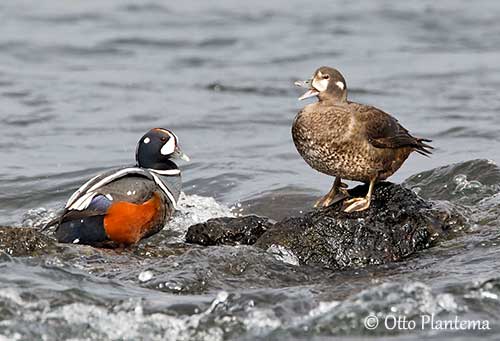
The Harlequin Duck feeds mostly by diving, often in tight-packed flocks in intertidal and subtidal zones. It also dabbles and head dips in shallow water. It takes aquatic preys from rocks just below the surface, or skims insects from the surface. But when feeding in groups, the ducks drive into water 3-4 metres deep, and they catch preys within 15-20 seconds of diving.
On rivers, its behaviour is close to that of the Torrent Duck in the Andes. It is able to swim easily against the current by using the swirls, but also the calm waters close to the shore. It also rushes on the water, mid-flying and mid-swimming, or jumps into the water from a rock.
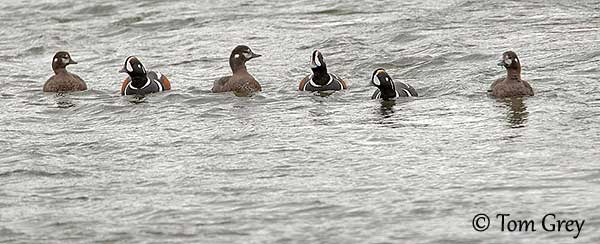
During the breeding season, the Harlequin Duck female looking for a mate always chooses a mate with bright plumage, indicating a powerful, healthy male, able to defend her against the rivals during this period. Male’s plumage is usually affected by age and such duck does not attract the females.
The males perform courtship dances to attract females. They shake both head and tail while producing high-pitched whistles when they swim around females. Males also perform short flights close to the water surface.
They are monogamous for a single breeding season. The male usually helps in nest-building, but it leaves and migrates back to the ocean for moulting as soon as the female starts to incubate. She rears the chicks alone.
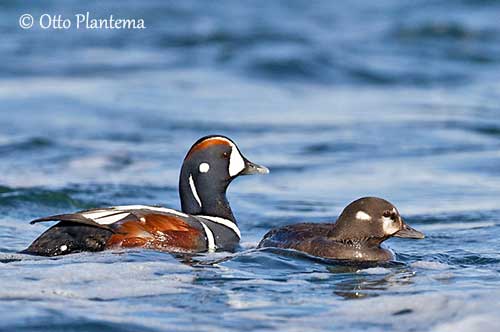
The Harlequin Duck is not truly migratory, but it disperses along the sea coasts in winter, within its breeding range. Males leave first in June, and females and young in early September. They moult during this period. They return to their breeding areas in late April and courtship displays often continue until mid-June.
The Harlequin Duck has fast, direct flight, usually flying low over the water and following the river’s course. It needs some running before rising into the air.
REPRODUCTION OF THIS SPECIES:
The breeding season starts in May-June. According to weather conditions, the peak laying occurs in the first half of June.
The male defends its mate but it is not territorial. The nest is on the ground, often on small island in river, and sometimes behind waterfalls. It is made in a hollow, lined with grass and down, and concealed among tall vegetation, among rocks, in cavities or occasionally in tree-holes up to 8 metres above the ground and close to the water.
The female lays 5-8 yellowish eggs and incubates alone during 27-29 days. At hatching, the chicks have grey down above and whitish below, and white cheeks. They fledge between 50 and 70 days after hatching, depending on the range. They are independent after the post-breeding dispersion to the seacoasts. They usually live in flocks during the winter.
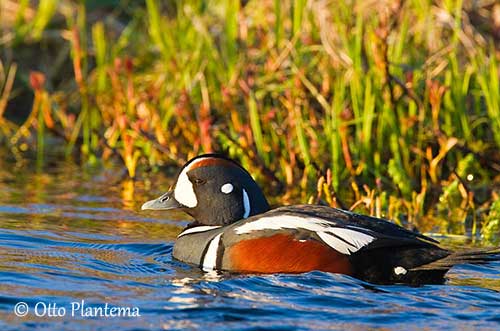
PROTECTION / THREATS / STATUS:
The Harlequin Duck is preyed upon by the Arctic Fox and the Grey Wolf, but also by Bald Eagles, jaegers and ravens, and on rivers by otters on adults, and mink and martens on nests. The species is widespread and common, and even locally abundant.
The population is estimated to number 190,000/380,000 individuals (2006), and is currently stable or even increasing.
The Harlequin Duck is evaluated as Least Concern.
